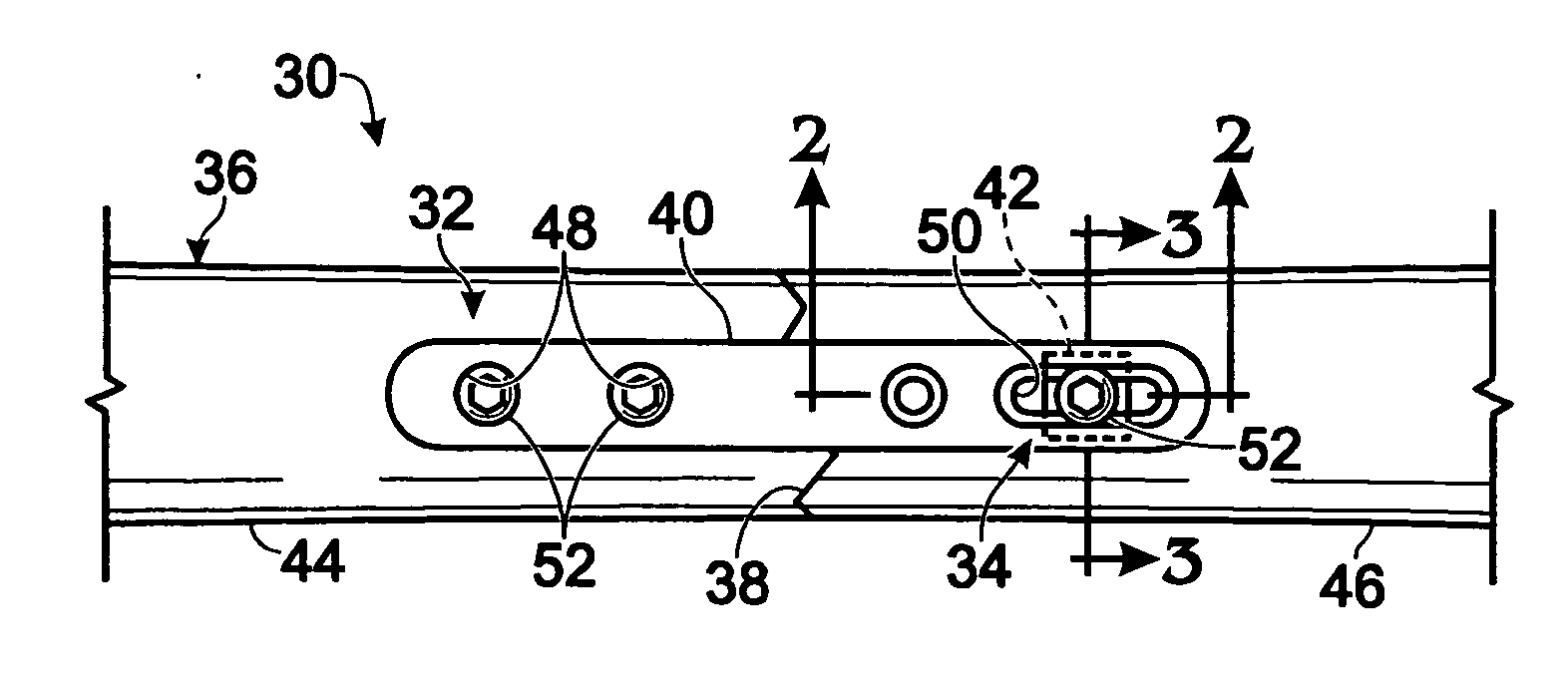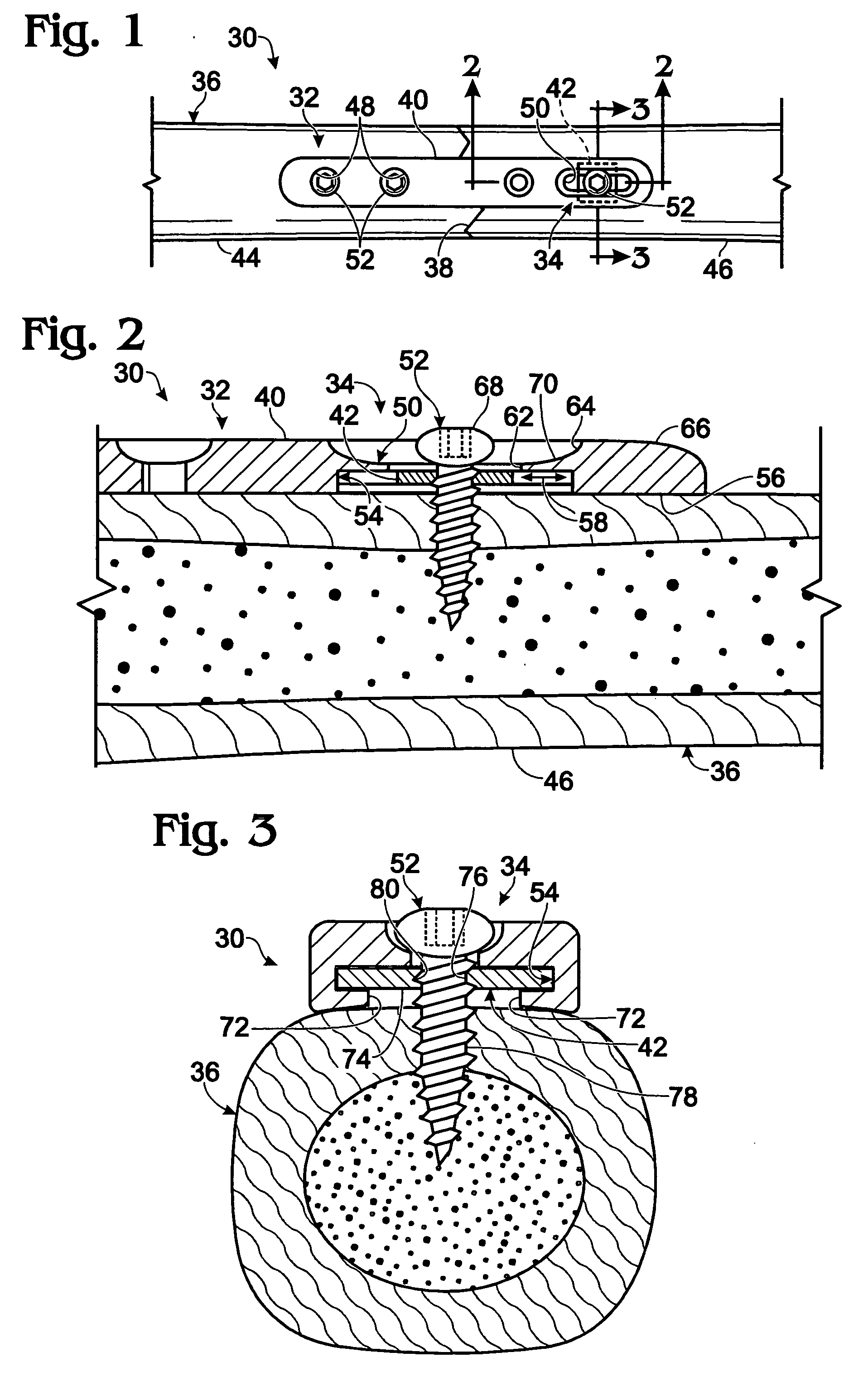Bone plates with movable locking elements
a technology of locking elements and bone plates, applied in the field of bone plates with movable locking elements, can solve the problems of unable to compress bone by perforations,
- Summary
- Abstract
- Description
- Claims
- Application Information
AI Technical Summary
Benefits of technology
Problems solved by technology
Method used
Image
Examples
example 1
Elongate Locking Aperture with Selectable Screw Angles
[0094] This example describes an exemplary fixation system 110 including a bone plate 111 that permits locked placement of bone screws at a range of angles; see FIGS. 6 and 7.
[0095]FIG. 6 shows a bone screw 112 extending through an elongate locking aperture 114 of the bone plate and into bone 115. Bone screw 112 may be locked to a locking element 116 of the locking aperture. The locking element may be disposed in a cavity 118 formed below an opening 120 defined by a plate body 122 of the bone plate.
[0096] The cavity may include a chamber or hollow 124 to which the locking element is confined. The chamber may be defined above flanges 126 of the plate body. Chamber 124 may have a depth (or height) that is greater than the thickness of the locking element, such that the locking element may move up and down within the chamber (i.e., parallel to an axis extending between the inner and outer faces of the plate body (namely, a thickn...
example 2
Elongate Locking Aperture with Biased Locking Element
[0099] This example describes an exemplary fixation system 150 including a bone plate 151 having a locking aperture 152 with a biased locking element 154; see FIGS. 8 and 9.
[0100] Locking element 154 may have a biasing mechanism 156 configured to position the locking element relative to a thickness axis 158 of a plate body 160 of the bone plate. In particular, the biasing mechanism may urge at least a portion of the locking element away from an outer face 162 and towards an inner face 164 of plate body 160. The biasing mechanism may be provided by one or more leaf springs created by tabs 166 extending with an angular disposition from a central region 168 of the locking element. The tabs may engage a ceiling surface 170 of a cavity 172 of the locking aperture. In addition, the tabs may be deformable to permit movement of the central region of the locking element generally parallel to thickness axis 158 of the plate body.
[0101]FI...
example 3
Exemplary Bone Plate with Elongate Locking Apertures
[0103] This example describes an exemplary bone plate 210 with an array of elongate locking apertures; see FIGS. 10-12.
[0104]FIGS. 10-12 show an exploded view, an end view, and an inner (bottom) view, respectively, of bone plate 210. The bone plate may include a plate body or plate member 212, a plurality of locking elements 214, and stop members 216.
[0105] Plate body 212 may define various openings that receive fasteners (such as bone screws), locking elements 214, or stop members 216. These openings may include one or more elongate openings 218, channel 220, and post openings 222. The plate body also or alternatively may define one or more non-elongate (e.g., circular) openings configured to receive fasteners, such as bone screws, pins, or wires, among others.
[0106] Elongate openings 218 may be arrayed along the long axis of the plate body. These elongate openings may be configured to receive bone screws at a range of positio...
PUM
 Login to View More
Login to View More Abstract
Description
Claims
Application Information
 Login to View More
Login to View More - R&D
- Intellectual Property
- Life Sciences
- Materials
- Tech Scout
- Unparalleled Data Quality
- Higher Quality Content
- 60% Fewer Hallucinations
Browse by: Latest US Patents, China's latest patents, Technical Efficacy Thesaurus, Application Domain, Technology Topic, Popular Technical Reports.
© 2025 PatSnap. All rights reserved.Legal|Privacy policy|Modern Slavery Act Transparency Statement|Sitemap|About US| Contact US: help@patsnap.com



